Coupled Thermomechanical Responses of Zirconium Alloy System Claddings under Neutron Irradiation
Abstract
1. Introduction
2. Thermomechanical Modelling Framework
2.1. Thermomechanical Model of UO2 Fuel
2.2. Thermomechanical Models of Zr Cladding
3. Finite Element Modeling
4. Results and Discussion
4.1. The Thermomechanical Behavior
4.2. The Change of Gap Distance
5. Conclusions
- The temperature field and stress field of the fuel element decreased gradually from the center to the surface along the radial direction, and the maximum value appeared in the core of the pellet.
- The results show that the distribution of the displacement field along the radial direction increased gradually from the center to the outer surface. The increase of the displacement of the outer surface of the pellet was due to the increase of the local thickness, which was due to the irradiation effect.
- Different alloy systems did not affect the distribution of the temperature field, displacement field, or stress field of the UO2/Zr fuel element under irradiation. The values of temperature, displacement, and stress change with the change of alloy system. The displacement and stress fields were more sensitive to the alloy system; that is, the macroscopic mechanical properties of the fuel element under irradiation were shown to be sensitive to alloy elements.
Author Contributions
Funding
Data Availability Statement
Conflicts of Interest
References
- Hallstadius, L.; Johnson, S.; Lahoda, E. Cladding for high performance fuel. Prog. Nucl. Energ. 2012, 57, 71–76. [Google Scholar] [CrossRef]
- Was, G.S.; Petti, D.; Ukai, S.; Zinkle, S. Materials for future nuclear energy systems. J. Nucl. Mater. 2019, 527, 151837. [Google Scholar] [CrossRef]
- Zinkle, S.J.; Was, G.S. Materials challenges in nuclear energy. Acta Mater. 2013, 61, 735–758. [Google Scholar] [CrossRef]
- Hosemann, P.; Frazer, D.; Fratoni, M.; Bolind, A.; Ashby, M.F. Materials selection for nuclear applications: Challenges and opportunities. Scripta Mater. 2018, 143, 181–187. [Google Scholar] [CrossRef]
- Lambrecht, M.; Malerba, L. Positron annihilation spectroscopy on binary Fe-Cr alloys and ferritic/martensitic steels after neutron irradiation. Acta Mater. 2011, 59, 6547–6555. [Google Scholar] [CrossRef]
- Reese, E.R.; Almirall, N.; Yamamoto, T.; Tumey, S.; Odette, G.R.; Marquis, E.A. Does rate dependence of Cr precipitation in an ion-irradiated Fe-18Cr alloy. Scripta Mater. 2018, 146, 213–217. [Google Scholar] [CrossRef]
- Williamson, R.L.; Novascone, S.R. Application of the BISON Fuel Performance Code to the FUMEX-III Coordinated Research Project; International Atomic Energy Agency (IAEA): Vienna, Austria, 2012. [Google Scholar]
- Thouvenin, G.; Ricaud, J.M.; Michel, B. Alcyone: The PLEIADES fuel performance code dedicated to multidimensional PWR studies. In Proceedings of the International Meeting on LWR Fuel Performance, Salamanca, Spain, 22–26 October 2006. [Google Scholar]
- Tang, C.B.; Jiao, Y.J.; Chen, P.; Li, H.M.; Zhou, Y. Numerical Simulation of Irradiation-Thermal-Mechanical Coupling Behaviors in Nuclear Fuel Rods. Nucl. Power Eng. 2017, 38, 180–184. (In Chinese) [Google Scholar]
- Li, M.; Li, H.M.; Chen, P.; Wang, H.Y.; Pu, Z.P.; Qi, M.; Zhu, F.W. Preliminary Numerical Simulation of Fuel Assembly Deformation under Non-Homogeneous Irradiation Environment. Nucl. Power Eng. 2017, 38, 7–10. [Google Scholar]
- Kong, X.; Tian, X.; Yan, F.; Ding, S.; Hu, S.; Burkes, D.E. Thermo-mechanical behavior simulation coupled with the hydrostatic-pressure-dependent grain-scale fission gas swelling calculation for a monolithic UMo fuel plate under heterogeneous neutron irradiation. Open Eng. 2018, 8, 243–260. [Google Scholar] [CrossRef]
- Yadav, A.K.; Shin, C.H.; Lee, S.U.; Kim, H.C. Experimental and numerical investigation on thermo-mechanical behavior of fuel rod under simulated LOCA conditions. Nucl. Eng. Des. 2018, 337, 51–65. [Google Scholar] [CrossRef]
- Patra, A.; Tome, C.N. Finite element simulation of gap opening between cladding tube and spacer grid in a fuel rod assembly using crystallographic models of irradiation growth and creep. J. Nucl. Mater. 2017, 315, 155–169. [Google Scholar] [CrossRef]
- Long, F.; Balogh, L.; Brown, D.W.; Mosbrucker, P.; Skippon, T.; Judge, C.D.; Daymond, M.R. Effect of neutron irradiation on deformation mechanisms operating during tensile testing of Zr-2.5Nb. Acta Mater. 2016, 102, 352–363. [Google Scholar] [CrossRef]
- Sarswat, P.K.; Jagannathan, M. Deflection behavior of focused-ion-beam deposited carbon nanocantilever and overhung structures. Adv. Mater. Lett. 2017, 8, 324–330. [Google Scholar] [CrossRef]
- Li, Y.; Ghoniem, N. Cluster dynamics modeling of irradiation growth in single crystal Zr. J. Nucl. Mater. 2020, 540, 152312. [Google Scholar] [CrossRef]
- Liu, J. Nuclear Structural Materials; Chemical Industry Press: Shanghai, China, 2007; pp. 30–35. [Google Scholar]
- Kareer, A.; Waite, J.C.; Li, B.; Couet, A.; Armstrong, D.E.J.; Wilkinson, A.J. Short communication: ‘Low activation, refractory, high entropy alloys for nuclear applications’. J. Nucl. Mater. 2019, 526, 151744. [Google Scholar] [CrossRef]
- Sarswat, P.K.; Sarkar, S.; Murali, A.; Huang, W.; Tan, W.; Free, M.L. Additive manufactured new hybrid high entropy alloys derived from the AlCoFeNiSmTiVZr system. Appl. Surf. Sci. 2019, 476, 242–258. [Google Scholar] [CrossRef]
- Lucuta, P.G.; Matzke, H.; Hastings, I.J. A pragmatic approach to modelling thermal conductivity of irradiated UO2 fuel: Review and recommendations. J. Nucl. Mater. 1996, 232, 166–180. [Google Scholar] [CrossRef]
- Carbajo, J.; Gradyon, L.; Popov, S.; Ivanov, V. A review of the thermophysical properties of MOx and UO2 fuels. J. Nucl. Mater. 2001, 299, 181–198. [Google Scholar] [CrossRef]
- Fink, J.K.; Leibowitz, L. Thermal conductivity of zirconium. J. Nucl. Mater. 1995, 226, 44–50. [Google Scholar] [CrossRef]
- Adamson, R.B.; Coleman, C.E.; Griffiths, M. Irradiation creep and growth of zirconium alloys: A critical review. J. Nucl. Mater. 2019, 521, 167–244. [Google Scholar] [CrossRef]
- Hagrman, D.L.; Reymann, G.A. Matpro-Version 11: A Handbook of Materials Properties for Use in the Analysis of Light Water Reactor Fuel Rod Behavior; Technical Report; Idaho National Engineering Lab.: Idaho Falls, ID, USA, 1979.
- Rashid, Y.; Dunham, R.; Montgomery, R. Fuel Analysis and Licensing Code: Falcon Mod01; Technical Report EPRI 1011308; Electric Power Research Institute: Washington, DC, USA, 2004. [Google Scholar]
- Holt, R.A.; Causey, A.R. Volume conservation during irradiation growth of Zr-2.5Nb. J. Nucl. Mater. 2004, 335, 529–533. [Google Scholar] [CrossRef]
- Williamson, R.L. Enhancing the ABAQUS thermomechanics code to simulate multipellet steady and transient LWR fuel rod behavior. J. Nucl. Mater. 2011, 415, 74–83. [Google Scholar] [CrossRef]
- Singh, G.; Terrani, K.; Katoh, Y. Thermo-mechanical assessment of full SiC/SiC composite cladding for LWR applications with sensitivity analysis. J. Nucl. Mater. 2018, 499, 126–143. [Google Scholar] [CrossRef]
- Cazado, M.E.; Goldberg, E.; Togneri, M.A.; Denis, A.; Soba, A. A new irradiation growth model for Zr-based components of nuclear reactors for the DIONISIO code. Nucl. Eng. Des. 2021, 373, 111009. [Google Scholar] [CrossRef]
- Li, W.; Shirvan, K. ABAQUS analysis of the SiC cladding fuel rod behavior under PWR normal operation conditions. J. Nucl. Mater. 2019, 555, 14–27. [Google Scholar] [CrossRef]
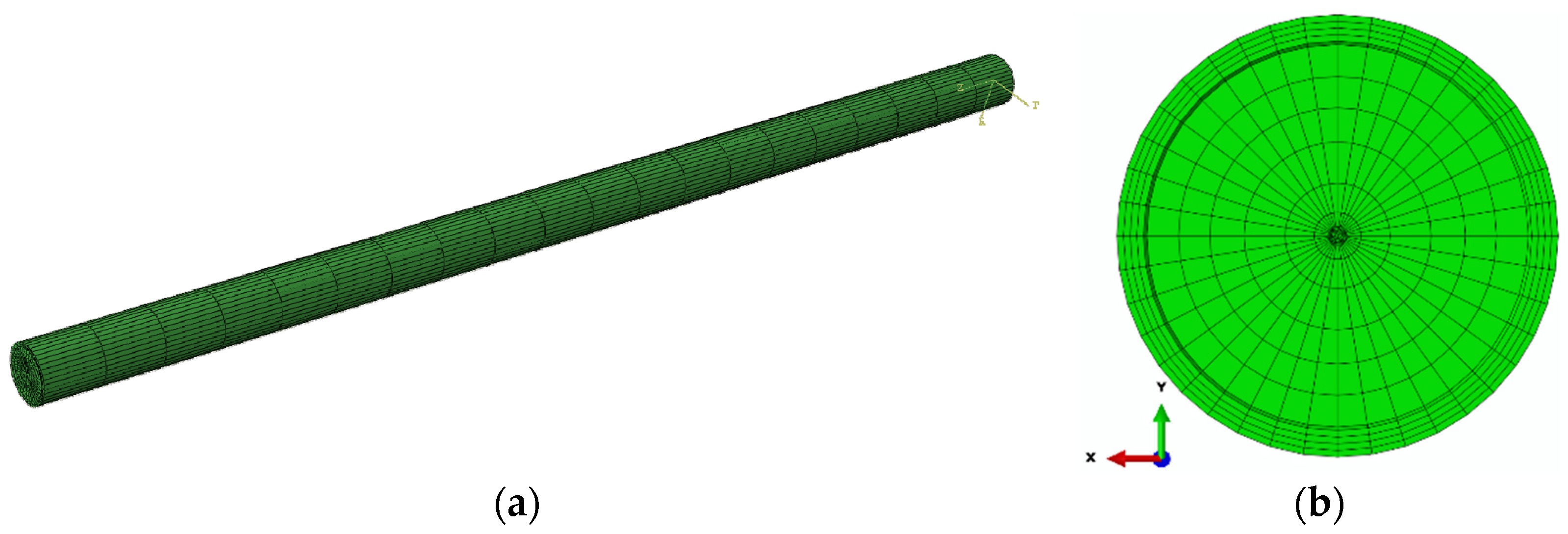

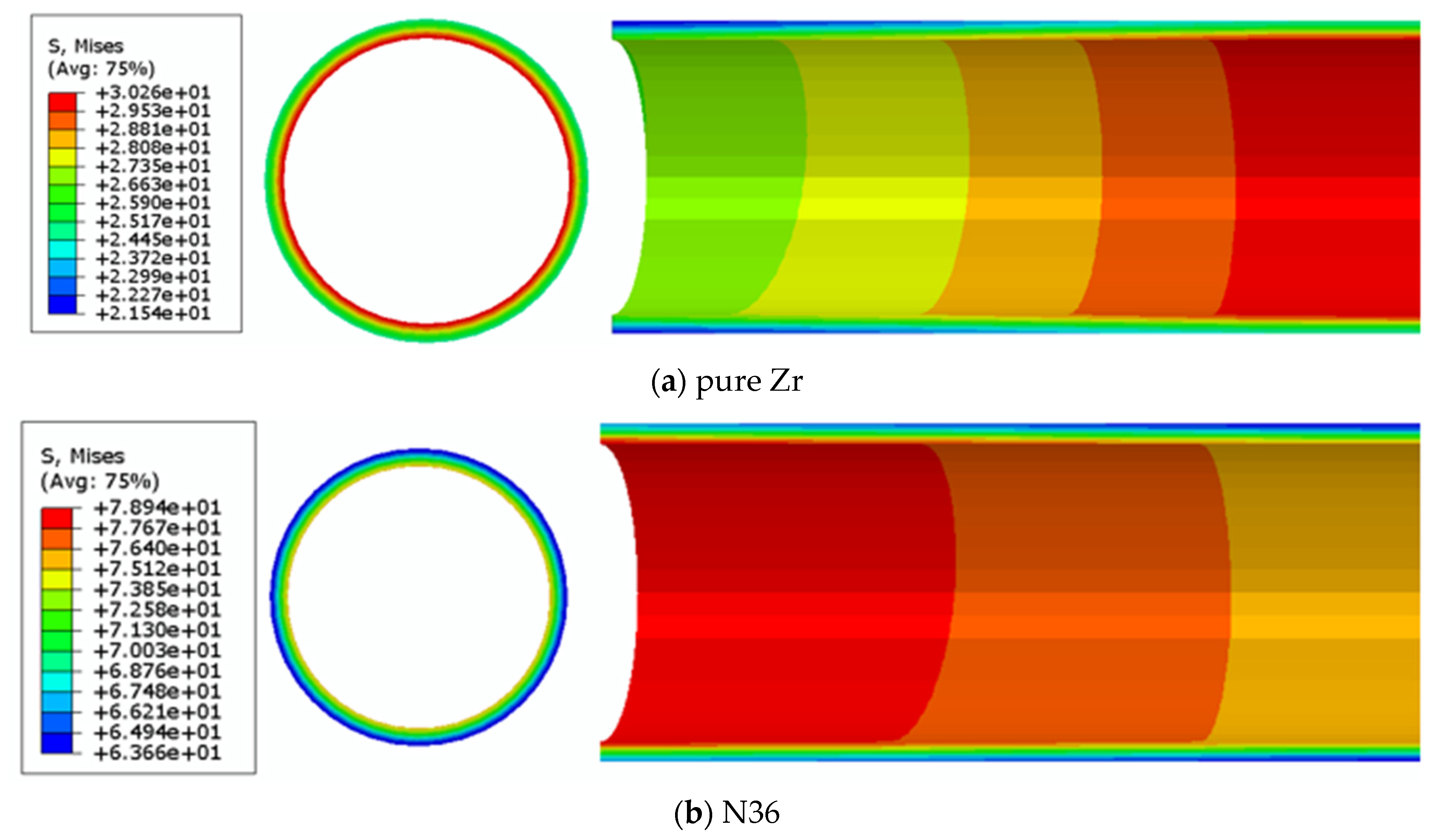
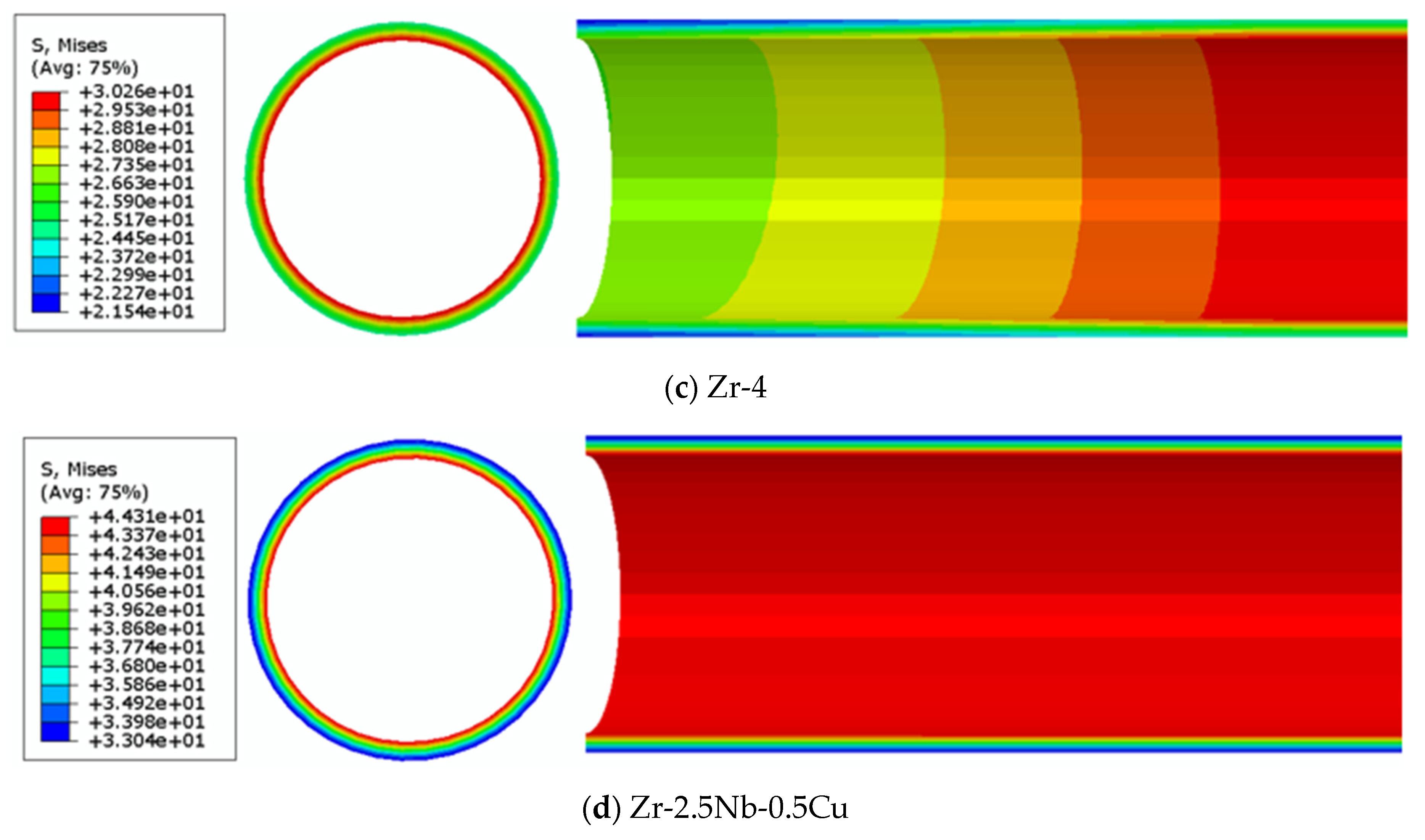
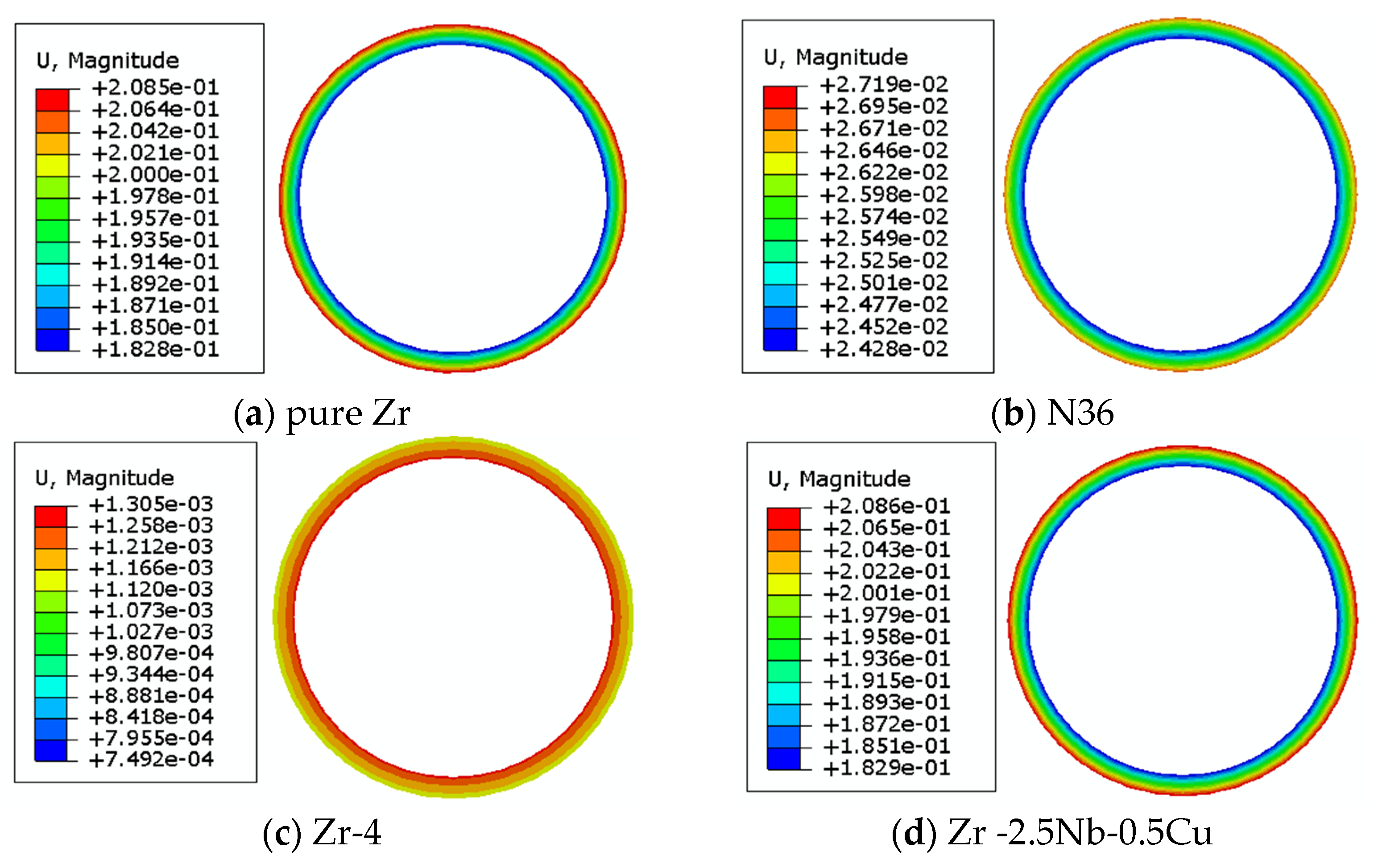
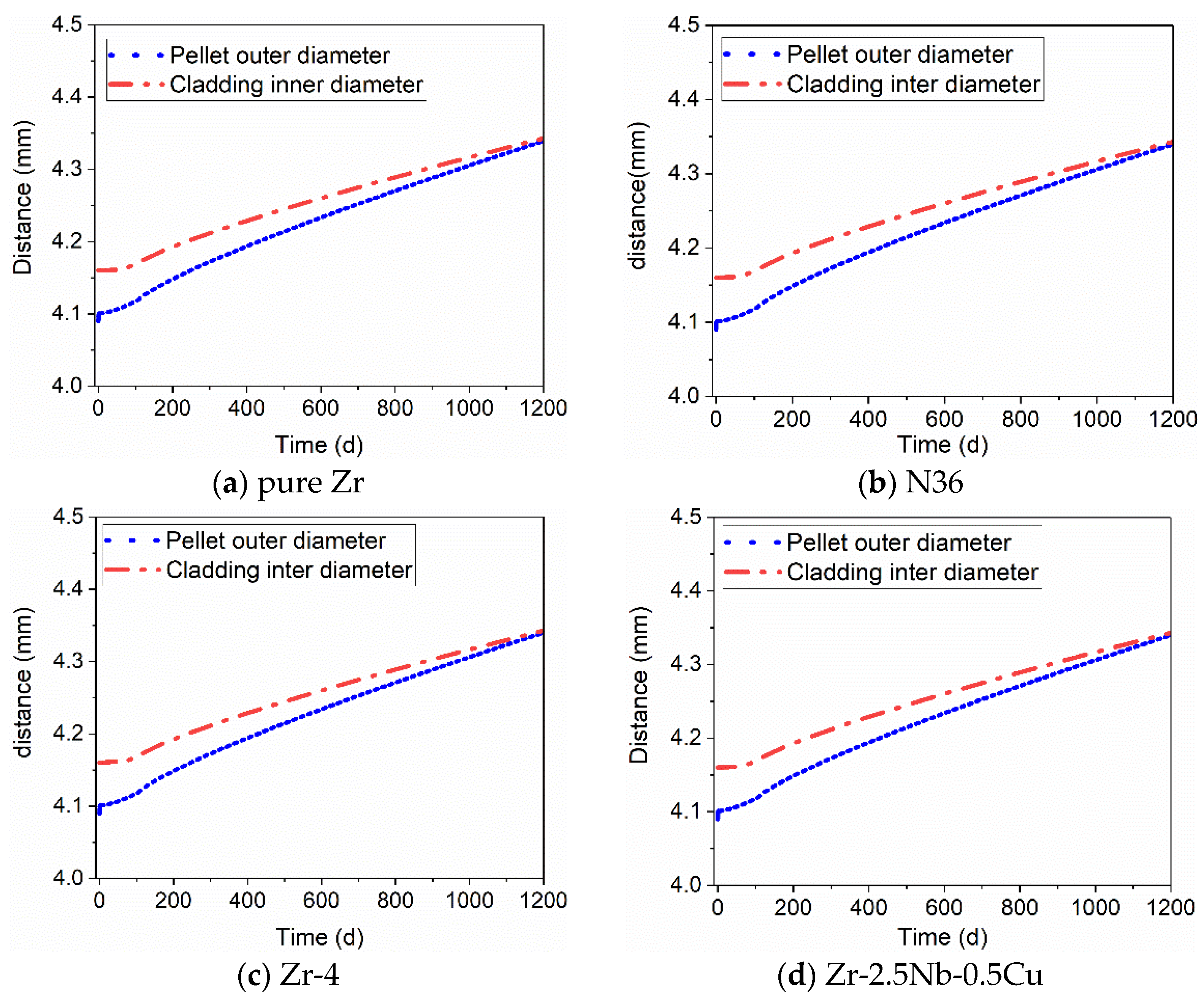
| Density g/cm3 | Temperature °C | Neutron Injection Quantity n/mm2 | Young’s Modulus GPa | Thermal Conductivity W/ (m·°C) | Poisson’s Ratio | Specific Heat Capacity J/(kg·°C) |
|---|---|---|---|---|---|---|
| 6.59 | 100 | 224 | 94.4 | 18.4 | 0.33 | 272 |
| - | 200 | 899 | 89.2 | 19.1 | - | 285 |
| - | 300 | 3376 | 82.4 | 19.6 | - | 301 |
| - | 400 | 1,746,000 | 73.8 | 20.7 | - | 318 |
| Density g/cm3 | Temperature °C | Neutron Injection Quantity n/mm2 | Young’s Modulus GPa | Thermal Conductivity W/ (m·°C) | Poisson’s Ratio | Specific Heat Capacity J/(kg·°C) |
|---|---|---|---|---|---|---|
| 6.59 | 100 | 224 | 88 | 7.46 | 0.3 | 283 |
| - | 200 | 899 | 83 | 11.17 | - | 314 |
| - | 300 | 3376 | 77 | 12.68 | - | 333 |
| - | 400 | 1,746,000 | 72 | 14.03 | - | 345 |
| Density g/cm3 | Temperature °C | Neutron Injection Quantity n/mm2 | Young’s Modulus GPa | Thermal Conductivity W/ (m·°C) | Poisson’s Ratio | Specific Heat Capacity J/(kg·°C) |
|---|---|---|---|---|---|---|
| 6.573 | 100 | 224 | 95.3 | 7.59 | 0.3 | 275 |
| - | 200 | 899 | 88.6 | 11.26 | - | 309 |
| - | 300 | 3376 | 83 | 12.75 | - | 326 |
| - | 400 | 1,746,000 | 77.2 | 14.52 | - | 335 |
| Density g/cm3 | Temperature °C | Neutron Injection Quantity n/mm2 | Young’s Modulus GPa | Thermal Conductivity W/ (m·°C) | Poisson’s Ratio | Specific Heat Capacity J/(kg·°C) |
|---|---|---|---|---|---|---|
| 6.49 | 100 | 224 | 95 | 7.46 | 0.3 | 283 |
| - | 200 | 899 | 89 | 11.17 | - | 314 |
| - | 300 | 3376 | 83 | 12.68 | - | 333 |
| - | 400 | 1,746,000 | 77 | 14.03 | - | 345 |
Publisher’s Note: MDPI stays neutral with regard to jurisdictional claims in published maps and institutional affiliations. |
© 2021 by the authors. Licensee MDPI, Basel, Switzerland. This article is an open access article distributed under the terms and conditions of the Creative Commons Attribution (CC BY) license (http://creativecommons.org/licenses/by/4.0/).
Share and Cite
Zhao, H.; Yang, C.; Guo, D.; Wu, L.; Mao, J.; Pan, R.; Qin, J.; Shi, B. Coupled Thermomechanical Responses of Zirconium Alloy System Claddings under Neutron Irradiation. Appl. Sci. 2021, 11, 1308. https://doi.org/10.3390/app11031308
Zhao H, Yang C, Guo D, Wu L, Mao J, Pan R, Qin J, Shi B. Coupled Thermomechanical Responses of Zirconium Alloy System Claddings under Neutron Irradiation. Applied Sciences. 2021; 11(3):1308. https://doi.org/10.3390/app11031308
Chicago/Turabian StyleZhao, Hui, Chong Yang, Dongxu Guo, Lu Wu, Jianjun Mao, Rongjian Pan, Jiantao Qin, and Baodong Shi. 2021. "Coupled Thermomechanical Responses of Zirconium Alloy System Claddings under Neutron Irradiation" Applied Sciences 11, no. 3: 1308. https://doi.org/10.3390/app11031308
APA StyleZhao, H., Yang, C., Guo, D., Wu, L., Mao, J., Pan, R., Qin, J., & Shi, B. (2021). Coupled Thermomechanical Responses of Zirconium Alloy System Claddings under Neutron Irradiation. Applied Sciences, 11(3), 1308. https://doi.org/10.3390/app11031308




